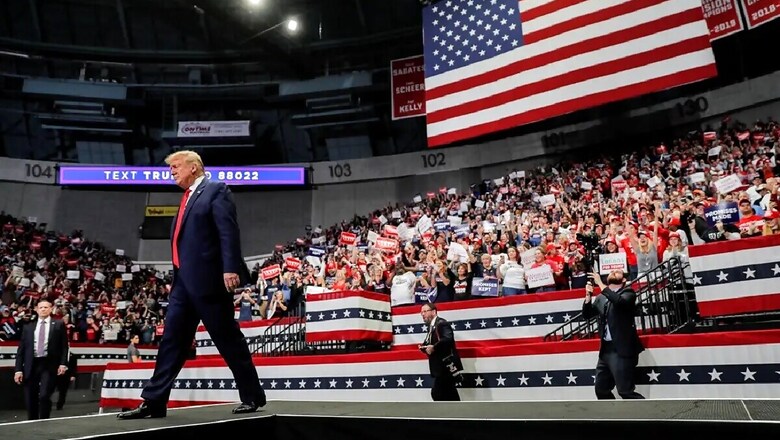
views
For President Donald Trump, the only thing that really matters is the size of his crowds. For Joe Biden, the road to the White House is full of honking cars.
As the two candidates for president closed out the final weekend of the 2020 campaign, which is unfolding in the middle of a health crisis, their venues not only contrasted their radically different positions on the coronavirus pandemic but offered revealing windows into the core of their political identities.
Trump is defined by his obsession with the size of his rallies, an almost inevitable bookend to his boastful exaggerations about the number of people who attended his inauguration four years ago. For the president, campaigning is a show, and its success is defined by the ratings that come with it: the crowds.
Biden has abandoned that instinct for large turnout in favor of drive-in rallies that underscore a central message of his campaign: that he will be more responsible than Trump in the face of a deadly pandemic. Biden’s socially distanced rallies, which draw hundreds, not thousands, of people in their vehicles, are the physical manifestation of his willingness to sacrifice numbers for safety.
Both men put those competing identities on display as they dashed across battleground states over the weekend.
Trump was holding rallies in five states Sunday after spending a full day in Pennsylvania on Saturday. As he crisscrossed the country, the president repeatedly marveled at the thousands of people who had turned out to see him and viciously mocked the smaller gatherings for his Democratic rival.
“And then you’d have like two cars honk — honk, honk,” Trump said in Washington, Michigan, on Sunday, as he complained repeatedly about the cold wind and the snow that fell throughout his remarks.
Trump bragged about attracting bigger crowds than Biden and former President Barack Obama, who campaigned together Saturday. “I hate to say it, Obama doesn’t draw any better,” he said. “They went as a twosome and they had less people.”
Trump enters his rallies to pounding music and crowds roaring their approval — with few people wearing masks — as he throws Make America Great Again hats into the stands like T-shirts at a basketball game. Aides say that he feeds off the energy of his audiences, and that the rallies have convinced Trump that he will win despite polls showing him trailing in almost all of the competitive states.
“A great red wave is forming,” Trump said Saturday in Newtown, Pennsylvania. “As sure as we’re here together, that wave is forming. And they see it, they see it on all sides, and there’s not a thing they can do about it.”
Jason Miller, a senior adviser for Trump’s campaign, said the president “loves campaigning” and is always eager for “the input from people outside the Beltway.”
But Trump is less enthusiastic when the input comes from smaller crowds. On Saturday morning, as he spoke to only about 300 people at his first Pennsylvania rally of the day, Trump was lethargic and subdued, as if he were privately thinking to himself: Yawn.
The night before, the president stalked off the stage in Rochester, Minnesota, after speaking for less than 30 minutes before a tiny crowd in a state where gatherings are limited to no more than 250 people. Trump claimed that there were “at least 25,000 people who wanted to be here tonight,” and said that his supporters were “barred from entry by radical Democrats.”
On Sunday, Trump also had rallies scheduled in Dubuque, Iowa; Hickory, North Carolina; Rome, Georgia; and Opa-Locka, Florida — the last one at 11 p.m.
Biden held campaign events in Michigan on Saturday and in Pennsylvania on Sunday, but with a twist: His supporters attend his rallies in their cars to ensure social distancing in the midst of the pandemic.
On a rainy Sunday evening in Philadelphia, Biden addressed supporters at a park where cars were parked on a muddy field. Earlier in the day, he appeared at another drive-in event outside a church in the city. And Saturday, Obama joined him for drive-in rallies in Flint, Michigan, and Detroit.
At the event in Flint, Obama mocked his successor for his “obsession” with crowd size, asking: “Did no one come to his birthday party when he was a kid? Was he traumatized?” He cited a recent study by Stanford researchers estimating that rallies held by Trump had resulted in tens of thousands of new coronavirus cases.
Biden has also faulted Trump for endangering his own supporters.
“I’m being responsible and I’m not becoming a great spreader of COVID,” Biden said last week, making explicit the distinction that he has been trying to draw for months. Trump, he said, is “putting thousands of people at risk.”
Biden’s drive-in rallies may be a campaign trail novelty, but they provide a way for his campaign to excite supporters in key areas and attract local news media coverage, much like a traditional rally would, while also observing public-health precautions.
“It’s a great way to show the enthusiasm and get the feeling of a campaign while being COVID safe,” said Jenn Ridder, the national states director for the Biden campaign. “People love them. They love the honking and the noise. I think people want to feel part of something, and especially in COVID.”
Michael D. Shear and Thomas Kaplan c.2020 The New York Times Company
Read all the Latest News and Breaking News here




















Comments
0 comment